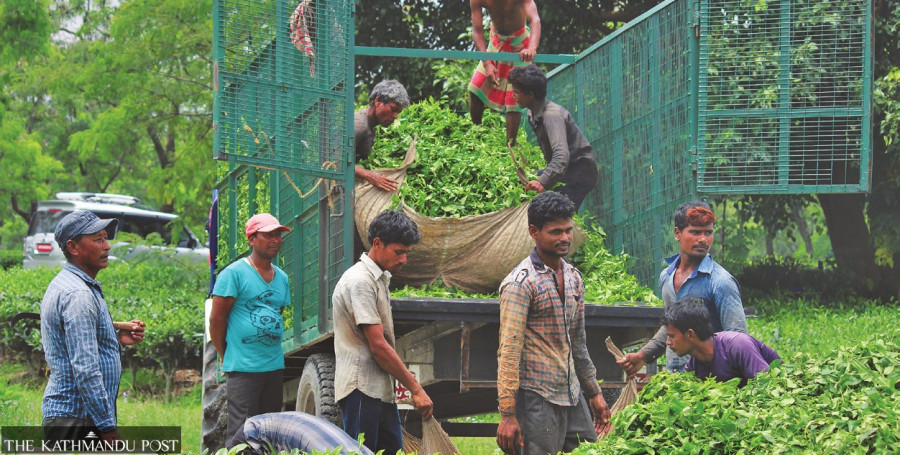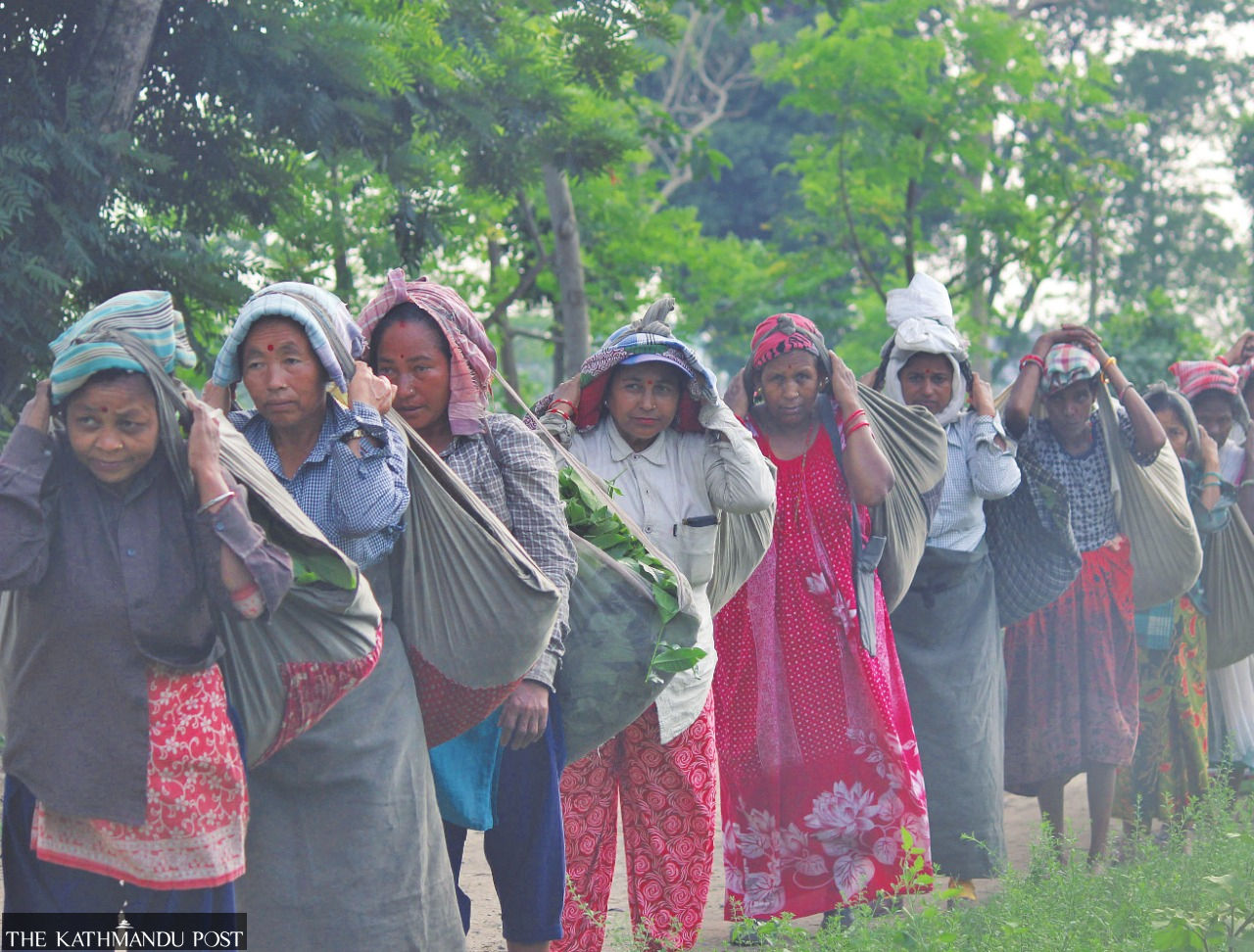
The government removed subsidies in the tea industry three years ago. Post File Photo
Tea farmer Parbat Dangi of Jhapa is used to facing regular shortages of chemical fertiliser, but this year things are especially bad. He does not have a grain of fertiliser to apply on his 10-bigha tea garden in Haldibari in Nepal’s eastern Tarai plains.
Dangi and scores of other tea producers who haven't been able to get chemical fertiliser know very well what to expect—reduced output.
Nepal’s Rs5-billion tea industry, which is one of the key foreign exchange earners for the country, is going through hard times.
Tea farmers in the country's eastern region have been facing acute shortages of urea, one of the most important sources of nitrogen.
The growers are worried because poor harvests due to lack of nutrients means reduced income for them, and life will become that much harder.
The government removed subsidies in the tea industry three years ago. Even then, tea producers have not been able to obtain the vital plant nutrients.
“Lack of chemical fertiliser will not only hit output but also quality,” said Dangi, who has been farming tea for the last 25 years. He has been facing fertiliser shortages every year, and he says things have worsened in the past three years.
Some farmers have bought contraband fertiliser brought across the Nepal-India border. “But it’s not easy, and it is very expensive,” said Dangi.
Nepal produces more than 25,000 tonnes of tea annually, according to the National Tea and Coffee Development Board. Of the total production, crush, tear and curl (CTC) tea makes up 19,000 tonnes.
Tea is one of the major exportable cash crops. The country earns more than Rs5 billion annually from tea production.
“The situation in the tea sector is bleak,” said Suresh Mittal, chairman of the Nepal Tea Producers Association. “Without chemical fertiliser, the plants won't produce fresh leaves.”
Nepal grows two types of tea: Camellia assamica for CTC tea which grows at lower altitudes and in the hot and humid plains of Nepal, primarily in Jhapa district. This tea accounts for almost 95 percent of domestic consumption owing to its lower cost of production.
Camellia sinensis or orthodox tea is grown at altitudes of 900 to 2,100 metres. Four districts in the eastern hills are known for producing quality orthodox tea—Ilam, Panchthar, Dhankuta and Tehrathum.
Ideally, orthodox tea is produced from the top two leaves and a bud from each branch.
Orthodox refers to a traditional production process where the plucked tea leaf is partially dried (withered), rolled and then fermented to give a light colour, unique aroma and fruity flavour. It usually fetches a higher price than CTC tea in view of its quality, demand in the market and higher cost of production.
Deepak Khanal, director of the National Tea and Coffee Development Board, says orthodox tea is grown without the use of chemical fertiliser. In contrast, CTC tea requires large amounts of chemical fertilisers.
“The government didn’t import urea on time,” said Khanal. “It would be a huge blow to the tea farmers who were expecting bumper harvest due to the good monsoon this year.”
But that’s unlikely to happen this year.
“If the fertiliser shortage prevails for another month, we expect to lose production by at least 30 percent,” said Dangi.
The tea producers have blamed the government for neglecting the tea sector despite having potential and demand in both domestic and international markets.

More than 60 percent of the manpower involved in the tea sector are women. Post File PhotoTea producers say that the future of tea farming is in jeopardy. Many of them have started switching to other crops.
According to a government report, the tea industry is an important part of Nepal’s rural economy as it plays a significant role in rural employment and income generation. More than 60 percent of the human resources involved in the tea sector are women, and smallholders account for a majority of the production.
A developed tea sector and increased tea exports will ultimately benefit women, generate employment and reduce poverty, various reports have shown.
Mittal says the government has increased the export incentive given to Nepali exportable goods from 5 to 8 percent in a bid to encourage production.
“But tea and coffee are not on the list. We are confused whether or not the government has removed the export incentives on tea and coffee,” said Khanal.
He says that the Finance and Industry ministries should clearly state whether tea and coffee are eligible for export incentives.
The tea sector has also been suffering from lack of irrigation systems and erratic electricity supply. “The board has taken up the subject with the provincial government several times,” said Khanal. “Government policy on the tea sector is not clear.”
Mittal says the government has even stopped providing interest subsidies to the tea sector from this year.
Nepal’s history of tea production dates back to the establishment of Ilam Tea Estate in 1863. But even after a century and a half, the government has not set up a lab centre which would ease the process to export tea.
Annually, hundreds of truckloads of Nepali tea are transported to Kolkata, India for a sample test in the labs there.
According to a government report, the Nepali teas exported to India are blended with Darjeeling tea as the two products are very similar in terms of quality. “This used to be done on a large scale before, and it is still being done to some extent.”
Indian tea producers have been urging their government to place a blanket ban on the import of cheap and low-quality leaves.
“Obviously, there are issues regarding the lab test,” Khanal said. “The Department of Food Technology and Quality Control should look into this issue seriously.”
According to Khanal, a Tea Testing and Research Centre is under construction with a Rs270 million joint investment by Suryodaya Municipality, Fikkal and the provincial government. “But it is not known whether the report produced by the testing centre will be valid for export,” he said.
Mittal said that many tea entrepreneurs were drawn to cultivating tea after the government announced an interest subsidy. “If the government shuts down this facility, there is no alternative but to switch to other crops,” he said.
In 2020, tea traders reaped a bonanza following a drop in output in the key growing countries, India and Sri Lanka, and increased demand in the global market.
But tea exports have seen a decline this fiscal year. According to Nepal Rastra Bank, shipments fell by 13.4 percent to Rs3 billion in the first 11 months of the current fiscal year ending in mid-June.
Nepal exported tea worth Rs3.79 billion in the last fiscal year, the highest export on record, due to the shortage of tea in the global market.
Tea producers lament that they are still forced to sell tea at the price set by Indian traders.
Harka Tamang, former member of the National Tea and Coffee Development Board, said there was a government scheme to destroy the tea sector. “The government has been withdrawing the facilities one after another,” he said. “There are also flaws in the policy to promote tea.”













